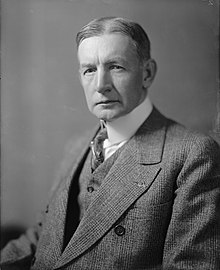
Back تشارلز جيتس دوز Arabic تشارلز جيتس دوز ARZ Charles Gates Dawes AST Çarlz Daues Azerbaijani چارلز قیتس دویز AZB Чарлз Гейтс Даўэс Byelorussian Чарлз Гейтс Даўэс BE-X-OLD Чарлс Дауес Bulgarian Charles Gates Dawes Catalan Charles G. Dawes CDO
Charles G. Dawes | |
|---|---|
 Dawes, c. 1920s | |
| 30th Vice President of the United States | |
| In office March 4, 1925 – March 4, 1929 | |
| President | Calvin Coolidge |
| Preceded by | Calvin Coolidge |
| Succeeded by | Charles Curtis |
| United States Ambassador to the United Kingdom | |
| In office June 15, 1929 – December 30, 1931 | |
| President | Herbert Hoover |
| Preceded by | Alanson B. Houghton |
| Succeeded by | Andrew Mellon |
| 1st Director of the Bureau of the Budget | |
| In office June 23, 1921 – June 30, 1922 | |
| President | Warren G. Harding |
| Preceded by | Position established |
| Succeeded by | Herbert Lord |
| 10th Comptroller of the Currency | |
| In office January 1, 1898 – September 30, 1901 | |
| President | William McKinley Theodore Roosevelt |
| Preceded by | James H. Eckels |
| Succeeded by | William Ridgely |
| Personal details | |
| Born | Charles Gates Dawes August 27, 1865 Marietta, Ohio, U.S. |
| Died | April 23, 1951 (aged 85) Evanston, Illinois, U.S. |
| Resting place | Rosehill Cemetery |
| Political party | Republican |
| Spouse | |
| Children | 4 |
| Education | Marietta College (AB) University of Cincinnati (LLB) |
| Civilian awards | Nobel Peace Prize |
| Signature |  |
| Military service | |
| Allegiance | United States |
| Branch/service | United States Army |
| Years of service | 1917–1919 |
| Rank | Brigadier general |
| Unit | American Expeditionary Forces Liquidation Commission of the War Department |
| Battles/wars | World War I |
| Military awards | Army Distinguished Service Medal |
Charles Gates Dawes (August 27, 1865 – April 23, 1951) was an American diplomat and Republican politician who was the 30th vice president of the United States from 1925 to 1929 under Calvin Coolidge. He was a co-recipient of the Nobel Peace Prize in 1925 for his work on the Dawes Plan for World War I reparations.
Born in Marietta, Ohio, Dawes attended Cincinnati Law School before beginning a legal career in Lincoln, Nebraska. After serving as a gas plant executive, he managed William McKinley's 1896 presidential campaign in Illinois. After the election, McKinley appointed Dawes as the Comptroller of the Currency. He remained in that position until 1901 before forming the Central Trust Company of Illinois. Dawes served as a general during World War I and was the chairman of the general purchasing board for the American Expeditionary Forces. In 1921, President Warren G. Harding appointed Dawes as the first director of the Bureau of the Budget. Dawes served on the Allied Reparations Commission, where he helped formulate the Dawes Plan to aid the struggling German economy.
The 1924 Republican National Convention nominated President Calvin Coolidge without opposition. After former Governor of Illinois Frank Lowden declined the vice-presidential nomination, the convention chose Dawes as Coolidge's running mate. The Republican ticket won the 1924 presidential election, and Dawes was sworn in as vice president in 1925. Dawes helped pass the McNary–Haugen Farm Relief Bill in Congress, but President Coolidge vetoed it. Dawes was a candidate for renomination at the 1928 Republican National Convention, but Coolidge's opposition to Dawes helped ensure that Charles Curtis was nominated instead. In 1929, President Herbert Hoover appointed Dawes to be the Ambassador to the United Kingdom. Dawes also briefly led the Reconstruction Finance Corporation, which organized a government response to the Great Depression. He resigned from that position in 1932 to return to banking, and died in 1951 of coronary thrombosis.
© MMXXIII Rich X Search. We shall prevail. All rights reserved. Rich X Search